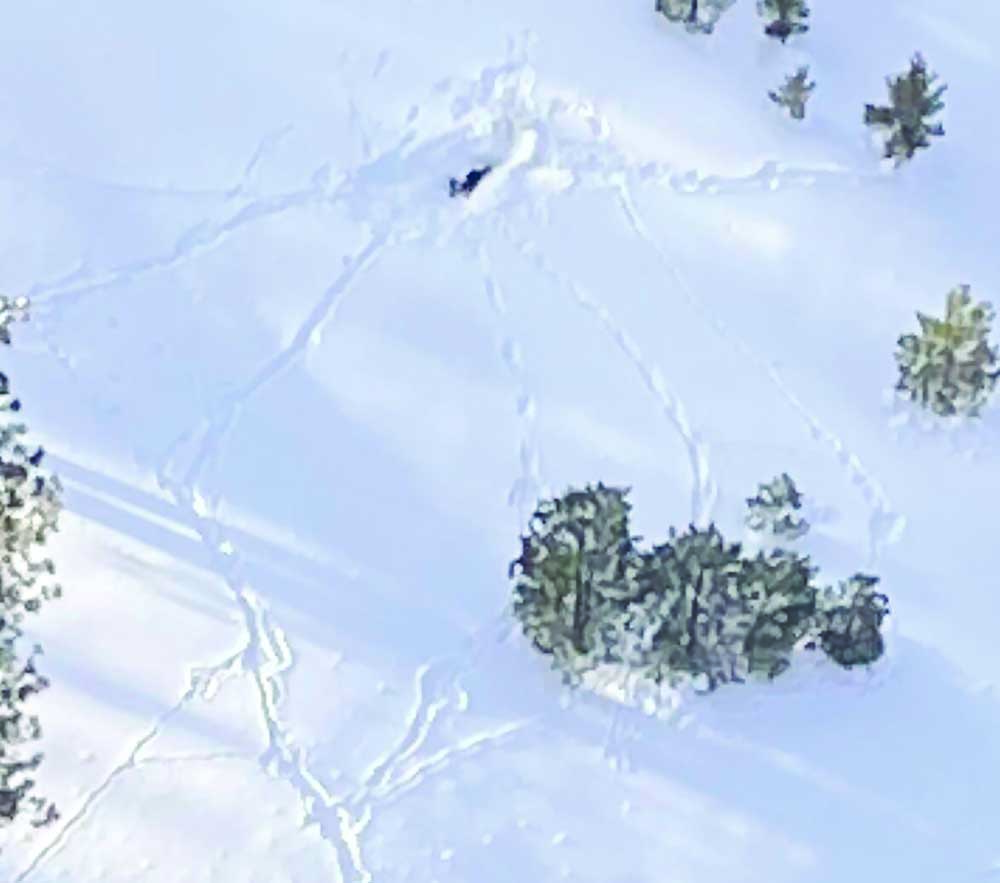2022 news in review: Wolves continue to plague county herds
Published 7:00 am Wednesday, December 28, 2022

- This aerial photo from early January shows a cow that died in the deep snows on the Upper Imnaha and its carcass dug up and eaten by wolves. Area ranchers are concerned that predation by wolves on cow carcasses will whet their appetite for live cattle.
WALLOWA COUNTY — Predatory wolves continue to be a threat to the livestock of Wallowa County ranchers, but not so much as last winter, according to Todd Nash, a rancher, county commissioner and president of the Oregon Cattlemen’s Association.
“It’s a very different year,” Nash said Thursday, Dec. 15. “We don’t have a bunch of naïve cattle who don’t know how to get home and a new permittee who doesn’t know how to get them home.”
During fall 2021, cattle mostly of the Bob Dean Ranch near Imnaha were left grazing on U.S. Forest Service land too late into the season and were hit by an early snowstorm. Many were pregnant and lost their calves, either to wolves or not being able to feed them because they were stuck in the snow.
The Chieftain reported this past year how numerous ranchers in the area went out and took bales of hay to the trapped cattle. Others used snowcats to try to pull the cattle loose from the snow and take them to safety. Ranchers put up many of the rescued cattle and fed them during the depth of winter.
Wallowa County Sheriff Joel Fish conducted an investigation into possible charges of animal neglect and turned the case over to county District Attorney Rebecca Frolander. However, Frolander said Dec. 20, she doesn’t yet have enough evidence to take animal neglect charges to a grand jury.
“This may stay an open case until either I get some evidence or I decide it’s not going to happen,” she said.
But it wasn’t just the snowbound cattle who offered wolves a chance to get the taste of beef.
Tom Birkmaier, a Crow Creek rancher of about 500 cattle and president of the Wallowa County Stockgrowers Association, suffered losses to wolves among his herd, despite repeated efforts at nonlethal measures to keep the wolves away.
Birkmaier lost a half-dozen animals to wolves of the Chesnimnus Pack in late April and early May. He asked the Oregon Department of Fish and Wildlife to remove the pack — meaning to kill them.
But Nash said the ODFW hasn’t been quite doing its job. He said effective management means killing wolves that have proven to have a taste for livestock.
“Some of those ranchers were requesting total pack removal,” he said. “What was offered up, most of the time, was the authority they already had.”
Ranchers in Eastern Oregon have the authority to kill predatory wolves that may be threatening their herds, so the few kill permits of a couple of wolves at a time meant little to the ranchers.
“It was up to the department to go out and take those lethal actions that were well within the boundaries of the Oregon wolf plan,” Nash said.
Birkmaier said Dec. 15 he has had no confirmed wolf kills since mid-June, but had one he suspected was a wolf in late November. He agreed with Nash.
“It’s very frustrating when a pack of wolves can have 11 confirmed depredations by ODFW in a 7½-month period, being known, chronic depredators of livestock and still be allowed to breed and roam freely to where we have have to deal with them again next year,” Birkmaier said. “I am fearful for myself and my fellow ranchers during the upcoming grazing season in 2023.”
While wolf attacks appear to have decreased in recent months, that’s not necessarily the case, said John Williams of Enterprise, who serves as the co-chairman for Eastern Oregon of the OCA’s Wolf Committee. He said that two Zumwalt Prairie depredation incidents in November occurred on the same rancher’s herd.
“They have been depredating all year,” Williams said. “It’s just they’ve been going on herds of ranchers who don’t report it and don’t believe it’s worth their time. … They did not take a break.”
He and Nash agreed that the ODFW needs to step up and do a more effective job of managing wolf populations.
“Effective management was never taken by ODFW and now those ranchers will have to face that all over again next spring, and that’s very unfortunate,” Nash said.





